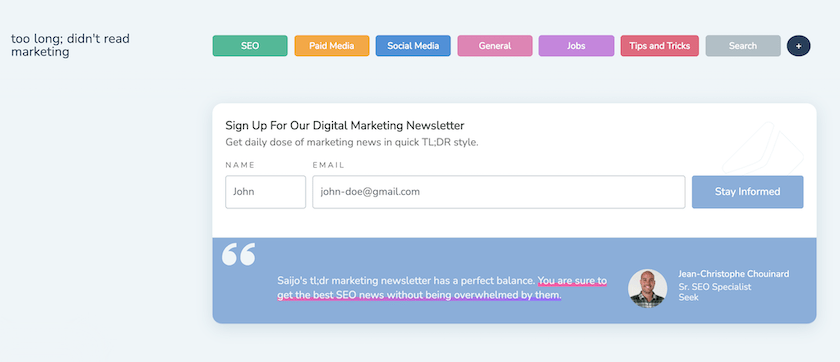As goals are set and growth plans are discussed, many agencies and digital tools get to the point where it is decided one method of grooming future clients might be through newsletters.
Surely there are good reasons for it as there are several great examples of excellent digital marketing newsletters to subscribe to. However, what is the strategy?
Why do some of these newsletters exist? It is not enough to syndicate out a constant stream of company blog posts that appear to be written by virtual assistants with minimal industry knowledge. That won’t work.
What type of content is needed?
Like any medium, the creative used depends entirely upon the target audience and the psychological triggers that audience will respond to. First, decide who it is that you’re targeting. For most digital agencies and tools, this isn’t too difficult, and I can cheat a bit because I am typically targeting some of the same buyer personas, such as readers of Digital Agency Network. For simplicity, let’s classify the buyer persona as either an owner or executive level in (or overseeing) the marketing function.
What does this buyer need? It’s the same response as my favorite answer to most SEO questions: it depends. If the buyer persona you’re targeting is more the end practitioner, then the content in a newsletter needs to be geared towards those in the weeds such as what is provided by Aleyda Solis’s #SEOFOMO and Kevin Indig’s Growth Memo.
The audience that we’re focused on, however, oversee these functions. What’s important to them? They don’t have time to try and understand the nuance of most technical pieces and thus need a broader overview of the information that can be delegated or acted upon at a higher level in order to either increase revenue, decrease costs, save time, or save focus.

Something like Saijo George’s TL;DR Marketing comes to mind for article summarization. For execs in the influencer niche, we all look forward to reading Friday’s summary of influencer news by Influence Weekly.
So, why should digital agencies start a newsletter?
There’s an importance of email marketing even for those agencies that don’t offer email marketing as a service. When done correctly, email allows for multiple touch points, but more importantly allows an agency to establish itself as an expert voice.
Further, email is a marketing channel that is considerably less volatile when compared to organic search and paid social, as most marketers can attest to.
Email is also an easy funnel entry point that is near frictionless. So long as you’re providing value in the newsletter in exchange for the email, funnel churn can be managed and allows for a simple contact mechanism when it’s time to move a prospect closer to purchase.
Another reason to incorporate a newsletter marketing strategy has to do with paid search and social; all these emails can be used as a primer for your retargeting and lookalike audiences.
The final reason is cost. Mailchimp, SendGrid, and most email platforms are dirt cheap when compared to other acquisition channels, making the barrier to entry close to nonexistent for even the most bootstrapped digital agencies.
How does one become an expert to the point where people will subscribe?
There are no shortcuts to becoming an expert. It requires thousands of hours of practice, patience, and perseverance to become viewed as a top tier influencer in your field.
Once recognized as an expert, allow your solutions team to use the newsletter subscribers for one-off personalized offerings that are extremely targeted to their prospective needs. Don’t mass email your base with a generic offer and expect action, as perceived expertise can be relinquished through such mistakes.
Wouldn’t it be nice to somehow accelerate that perceived expertise more quickly than the typical 10,000 hour guideline?
Despite having over 20 years’ experience in the trenches of organic search, email, paid and content marketing, I was “new” to the field when building Intellifluence and needed to write a book before getting callbacks from the largest CPGs. The moment I started getting the co-citations, the doors opened.
As the goal is to become an expert and perceived as such by prospective clients, one method that continually works is to leech off of other experts via co-citations across multiple mediums. Newsletters are no exception; for that you’ll need to attract authoritative influencers.
What are authoritative newsletter influencers?
Within the world of influencer marketing, one can generally bucket influencers into three categories: peer-level micro-influencers, aspirational or celebrity influencers, and expert-level authoritative influencers. As the names are fairly descriptive, aspirational influencers are public figures with large yet generalized audiences; peers are small audiences but can be highly effective when utilized in aggregate; authorities are those perceived experts that you’re after.
We all know experts in the digital space. If you’re first starting out it can be difficult to attract them for your newsletter, so the recommendation is to incorporate content they’ve created elsewhere as an ego stroking measure.
To improve effectiveness while also growing your list, forward a copy of the curated newsletter to the experts in question and ask if you can advertise on their own list as you’ve received so much value that you believe their audience would be ideal as a complement to what you’re focused on.
In later stages, as relationships are cultivated, you can court these influencers on an authoritative YouTube strategy and pair it with co-cited blog posts on authoritative publications like Digital Agency Network as a means to further establish yourself.
As a final step in the process, as your co-cited content becomes plentiful, pay for the content inclusion into any other relevant newsletters that will take your money.
Eventually, as you and your agency are perceived as the expert, it will be possible to have other newsletter owners introduce your product as well as your content, explaining how he or she uses it and then including a special offer for the newsletter audience that ties back to your core offering.


